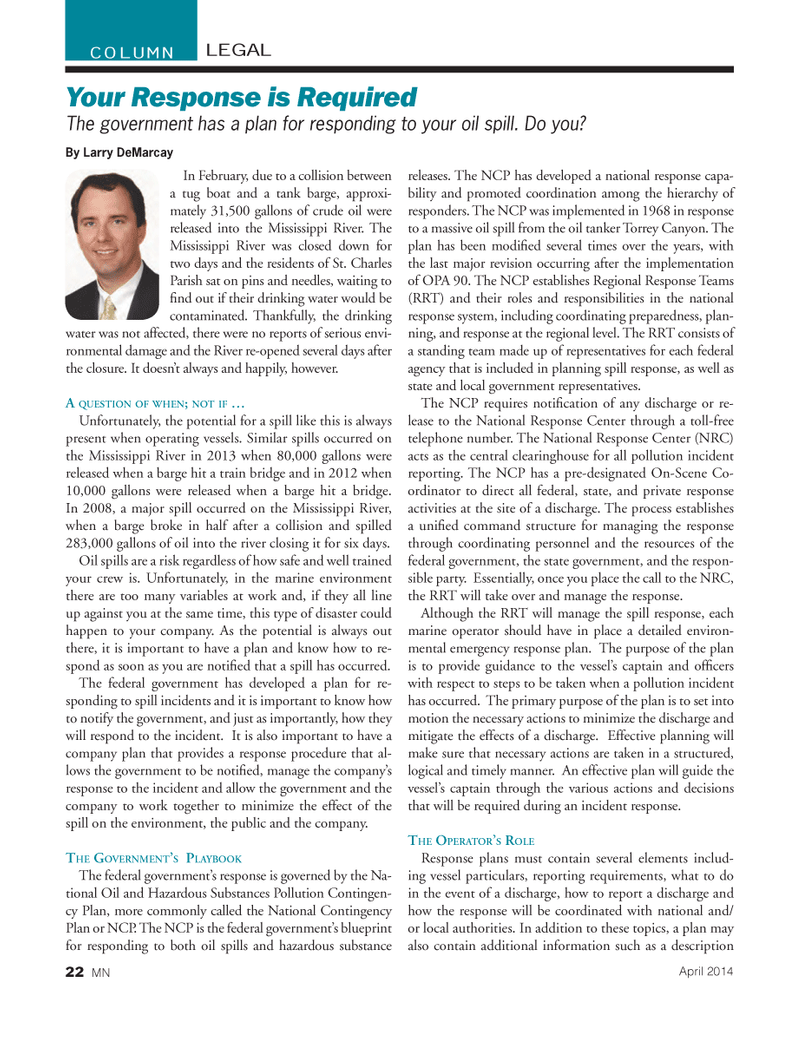
Page 22: of Marine News Magazine (April 2014)
Shipyard Report: Construction & Repair
Read this page in Pdf, Flash or Html5 edition of April 2014 Marine News Magazine
In February, due to a collision between a tug boat and a tank barge, approxi- mately 31,500 gallons of crude oil were released into the Mississippi River. The Mississippi River was closed down for two days and the residents of St. Charles Parish sat on pins and needles, waiting to Þ nd out if their drinking water would be contaminated. Thankfully, the drinking water was not affected, there were no reports of serious envi- ronmental damage and the River re-opened several days after the closure. It doesnÕt always and happily, however. A QUESTION OF WHEN; NOT IF ?Unfortunately, the potential for a spill like this is always present when operating vessels. Similar spills occurred on the Mississippi River in 2013 when 80,000 gallons were released when a barge hit a train bridge and in 2012 when 10,000 gallons were released when a barge hit a bridge. In 2008, a major spill occurred on the Mississippi River, when a barge broke in half after a collision and spilled 283,000 gallons of oil into the river closing it for six days. Oil spills are a risk regardless of how safe and well trained your crew is. Unfortunately, in the marine environment there are too many variables at work and, if they all line up against you at the same time, this type of disaster could happen to your company. As the potential is always out there, it is important to have a plan and know how to re- spond as soon as you are notiÞ ed that a spill has occurred. The federal government has developed a plan for re- sponding to spill incidents and it is important to know how to notify the government, and just as importantly, how they will respond to the incident. It is also important to have a company plan that provides a response procedure that al- lows the government to be notiÞ ed, manage the companyÕs response to the incident and allow the government and the company to work together to minimize the effect of the spill on the environment, the public and the company. THE GOVERNMENT ?S PLAYBOOK The federal governmentÕs response is governed by the Na- tional Oil and Hazardous Substances Pollution Contingen- cy Plan, more commonly called the National Contingency Plan or NCP. The NCP is the federal governmentÕs blueprint for responding to both oil spills and hazardous substance releases. The NCP has developed a national response capa- bility and promoted coordination among the hierarchy of responders. The NCP was implemented in 1968 in response to a massive oil spill from the oil tanker Torrey Canyon. The plan has been modiÞ ed several times over the years, with the last major revision occurring after the implementation of OPA 90. The NCP establishes Regional Response Teams (RRT) and their roles and responsibilities in the national response system, including coordinating preparedness, plan- ning, and response at the regional level. The RRT consists of a standing team made up of representatives for each federal agency that is included in planning spill response, as well as state and local government representatives. The NCP requires notiÞ cation of any discharge or re- lease to the National Response Center through a toll-free telephone number. The National Response Center (NRC) acts as the central clearinghouse for all pollution incident reporting. The NCP has a pre-designated On-Scene Co- ordinator to direct all federal, state, and private response activities at the site of a discharge. The process establishes a uniÞ ed command structure for managing the response through coordinating personnel and the resources of the federal government, the state government, and the respon- sible party. Essentially, once you place the call to the NRC, the RRT will take over and manage the response. Although the RRT will manage the spill response, each marine operator should have in place a detailed environ- mental emergency response plan. The purpose of the plan is to provide guidance to the vesselÕs captain and ofÞ cers with respect to steps to be taken when a pollution incident has occurred. The primary purpose of the plan is to set into motion the necessary actions to minimize the discharge and mitigate the effects of a discharge. Effective planning will make sure that necessary actions are taken in a structured, logical and timely manner. An effective plan will guide the vesselÕs captain through the various actions and decisions that will be required during an incident response. THE OPERATOR ?S ROLEResponse plans must contain several elements includ- ing vessel particulars, reporting requirements, what to do in the event of a discharge, how to report a discharge and how the response will be coordinated with national and/ or local authorities. In addition to these topics, a plan may also contain additional information such as a description LEGALCOLUMNYour Response is Required The government has a plan for responding to your oil spill. Do you? By Larry DeMarcay 22 MNApril 2014MN April14 Layout 18-31.indd 22MN April14 Layout 18-31.indd 223/20/2014 11:49:36 AM3/20/2014 11:49:36 AM

 21
21

 23
23
